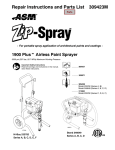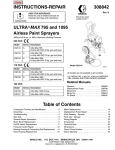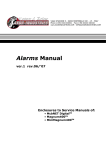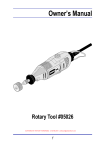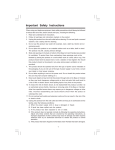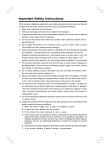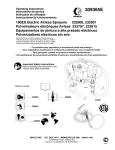Download Graco 190ES 309063F User's Manual
Transcript
REPAIR 309063F Important Safety Instructions Read all warnings and instructions in this manual. Save these instructions. First choice when quality counts.t - For portable spray applications of architectural paints and coatings - 190ESt Airless Paint Sprayers 3000 psi (207 bar, 20.7 MPa ) Maximum Working Pressure 120 VAC 232900, A, B, C, D, E, F 232901, A, B, C, D, E 233797, A, B, C, D, E 233815, A, B, C, D, E 100--120 VAC 232903, A, B 220--240 VAC ti7400a 232906, A, B 232900 . . . . . . . 309365 . . . . . . . 309060 . . . . . . . 309045 . . . . . . . . . . . . . . . . . . . . . 309064 . . . . . . . 309065 Table of Contents Component Function and Identification . . . . . . . . . . . . 5 Pressure Relief Procedure . . . . . . . . . . . . . . . . . . . . . . . 6 General Repair Information . . . . . . . . . . . . . . . . . . . . . . 7 Grounding . . . . . . . . . . . . . . . . . . . . . . . . . . . . . . . . . . . . . 8 Troubleshooting . . . . . . . . . . . . . . . . . . . . . . . . . . . . . . . . 9 Spin Test . . . . . . . . . . . . . . . . . . . . . . . . . . . . . . . . . . . . . 12 Motor Brush Replacement . . . . . . . . . . . . . . . . . . . . . 12 On/Off Switch Replacement . . . . . . . . . . . . . . . . . . . . 14 Pressure Control Repair . . . . . . . . . . . . . . . . . . . . . . . 19 Drive Housing Replacement . . . . . . . . . . . . . . . . . . . . 24 Motor Replacement . . . . . . . . . . . . . . . . . . . . . . . . . . . . 25 Displacement Pump Replacement . . . . . . . . . . . . . . . 26 Technical Data . . . . . . . . . . . . . . . . . . . . . . . . . . . . . . . . 27 Graco Phone Number . . . . . . . . . . . . . . . . . . . . . . . . . . 28 Graco Warranty . . . . . . . . . . . . . . . . . . . . . . . . . . . . . . . 28 Specifications This equipment is not intended for use with flammable or combustible materials used in places such as cabinet shops or other “factory” or fixed locations. If you intend to use this equipment in this type of application, you must comply with NFPA 33 and OSHA requirements for the use of flammable and combustible materials. Warnings Warning Symbol WARNING This symbol alerts you to the possibility of serious injury or death if you do not follow the instructions. 2 309063 Caution Symbol CAUTION This symbol alerts you to the possibility of damage to or destruction of equipment if you do not follow the instructions. The following are general Warnings related to the safe setup, use, maintenance and repair of this equipment. Additional, more specific warnings may be found throughout the text of this manual where applicable. WARNING FIRE AND EXPLOSION HAZARD Flammable fumes, such as solvent and paint fumes, in work area can ignite or explode. To help prevent fire and explosion: D Use equipment only in well ventilated area. D When flammable liquid is used in or near sprayer or for flushing or cleaning, keep sprayer at least 20 feet (6 m) away from explosive vapors. D Eliminate all ignition sources; such as pilot lights, cigarettes, portable electric lamps, and plastic drop clothes (potential static arc). D Keep work area free of debris, including solvent, rags and gasoline. D Do not plug or unplug power cords, or turn lights on or off when flammable fumes are present. D Ground equipment and conductive objects in work area. See Grounding instructions. D Use only grounded hoses. D Hold gun firmly to side of grounded pail when triggering into pail. D If there is static sparking or you feel a shock, stop operating immediately. Do not use equipment until you identify and correct the problem. D Keep a fire extinguisher in the work area. ELECTRIC SHOCK HAZARD Improper grounding, setup, or usage of the system can cause electric shock. D Turn off and disconnect power cord before servicing equipment. D Use only grounded electrical outlets D Use only 3--wire extension cords. D Ensure ground prongs are intact on sprayer and extension cords. SKIN INJECTION HAZARD High pressure fluid from gun, hose leaks, or ruptured components will pierce skin. This may look like just a cut, but it is a serious injury that can result in amputation. Get immediate surgical treatment. D Do not point gun at anyone or any part of the body. D Do not put your hand over the spray tip. D Do not stop or deflect leaks with your hand, body, glove, or rag. D Do not spray without tip guard and trigger guard installed. D Engage trigger lock when not spraying. D Follow Pressure Relief Procedure in this manual, when you stop spraying and before cleaning, checking or servicing equipment. 309063 3 EQUIPMENT MISUSE HAZARD Misuse can cause death or serious injury. INSTRUCTIONS D Do not exceed the maximum working pressure or temperature rating of the lowest rated system component. Read Technical Data in all equipment manuals. D Use fluids and solvents that are compatible with equipment wetted parts. Read Technical Data in all equipment manuals. Read fluid and solvent manufacturer’s warnings. D Check equipment daily. Repair or replace worn or damaged parts immediately. D Do not alter or modify equipment. D Use equipment only for its intended purpose. Call your Graco distributor for information. D Route hoses and cables away from traffic areas, sharp edges, moving parts and hot surfaces. D Do kink or overbend hoses or use hoses to pull equipment. D Keep children and animals away from work area. D Comply with all applicable safety regulations. PRESSURIZED ALUMINUM PARTS HAZARD Do not use 1,1,1-trichloroethane, methylene chloride, other halogenated hydrocarbon solvents or fluids containing such solvents in pressurized aluminum equipment. Such use can cause serious chemical reaction and equipment rupture, and result in death, serious injury, and property damage. BURN HAZARD Equipment surfaces can become very hot during operation. To avoid sever burns, do not touch hot equipment. Wait until equipment has cooled completely. TOXIC FLUID HAZARD Toxic fluid or fumes can cause serious injury or death if splashed in the eyes or on skin, inhaled, or swallowed. D Read MSDS’s to know the specific hazards of the fluids you are using. D Store hazardous fluid in approved containers and dispose of it according to all applicable guidelines. PERSONAL PROTECTIVE EQUIPMENT You must wear appropriate protective equipment when operating, servicing, or when in the operating area of the equipment to help protect you from serious injury, including eye injury, inhalation of toxic fumes, burns, and hearing loss. This equipment includes, but is not limited to: D Protective eye wear. D Clothing and respirator as recommended by the fluid and solvent manufacturer. D Gloves. D Hearing protection. MOVING PARTS HAZARD Moving parts can pinch or amputate fingers and other body parts. D Keep clear of moving parts. D Do not operate equipment with protective guards or covers removed. D Pressurized equipment can start without warning. Before checking, moving, or servicing equipment, follow the Pressure Relief Procedure in this manual. Disconnect power or air supply. 4 309063 Component Identification and Function H A J B V U R P S T K F D ti7400a ti5914a N E G M A Motor DC motor, permanent magnet, fan cooled B Drive Assembly Transfers power from DC motor to displacement pump D Displacement Pump Transfers fluid to be sprayed from source through spray gun E Fluid Outlet Spray gun is connected here F Prime Valve Used to prime and drain sprayer (also relieves fluid outlet pressure) when open G Fluid Filter (optional) Final filter of fluid to spray gun H Pressure Adjusting Knob Controls fluid outlet pressure J Pressure Control Controls motor speed to maintain fluid outlet pressure at displacement pump outlet. Works with pressure adjusting knob. K ON/OFF Switch Power switch that controls main power to sprayer M 50 ft (15 m) Main Hose 1/4 in. ID, grounded, nylon hose with spring guards on both ends N Spray Gun High pressure spray gun with gun safety latch P RAC IV Switch Tip Uses high pressure fluid to clear tip clogs without removing tip from spray gun R Tip Guard Tip guard reduces risk of injection injury S Thumb Lock Safety Gun safety latch inhibits accidental triggering of spray gun T Power Cord Rack Holds wrapped power cord for storage U Suction Hose Transfers fluid to be sprayed from source to pump V Drain Tube Fluid outlet used to drain and prime the sprayer 309063 5 Pressure Relief Procedure WARNING SKIN INJECTION HAZARD Follow this Pressure Relief Procedure whenever you are instructed to relieve pressure, stop spraying, check or service equipment, or install or clean spray tip. read Injection Hazard Warning. 1. Turn OFF power and turn pressure control to lowest pressure setting. 2. Hold gun against side of grounded metal flushing pail. Trigger gun to relieve pressure. Fig. 2 If suspected that spray tip or hose is clogged or that pressure has not been fully relieved after following steps above , VERY SLOWLY loosen tip guard retaining nut or hose end coupling to relieve pressure gradually, then loosen completely. Clear tip or hose obstruction. 4. Engage trigger safety lock on gun if unit is being shut down or left unattended. CAUTION To reduce risk of pressure control malfunction: D Use needle nose pliers to disconnect wire. Never pull on wire, pull on connector. D Mate wire connectors properly. Center flat blade of insulated male connector in female connector. D Route wires carefully to avoid interference with other connections of pressure control. Do not pinch wires between cover and control box. ti7401a FLUSH Fig. 1 3. Turn prime valve down 6 309063 General Repair Information WARNING Read Electric Shock Warning and Burn Hazard Warning. WARNING To reduce risk of serious injury, including electric shock: D Do not touch moving or electric parts with fingers or tools while testing repair D Unplug sprayer when power is not required for testing WARNING Flammable materials spilled on hot, bare, motor could cause fire or explosion. To reduce risk of burns, fire or explosion, do not operate sprayer with cover removed. D Keep all screws, nuts, washers, gaskets, and electrical fittings removed during repair procedures. These parts usually are not provided with replacement kits. D test repairs after problems are corrected. D If sprayer does not operate properly, review repair procedure to verify you did it correctly. See Troubleshooting, page 9. D Overspray may build up in the air passages. Remove any overspray and residue from air passages and openings in the enclosures whenever you service sprayer. D Do not operate the sprayer without the motor shroud in place. replace if damaged. Motor shroud directs cooling air around motor to prevent overheating and insulate the control board from accidental electric shock. D Install all covers, gaskets, screws and washers before you operate sprayer CAUTION D Do not run sprayer dry for more than 30 seconds. Doing so could damage pump packings. D Protect the internal drive parts of this sprayer from water. openings in the cover allow for air cooling of the mechanical parts and electronics inside. If water gets in these openings, sprayer could malfunction or be permanently damaged. D Prevent pump corrosion and damage from freezing. Never leave water or water--base paint in sprayer when it is not in use in cold weather. Freezing fluids can seriously damage sprayer. Store sprayer with Pump armour to protect sprayer during storage. D Do not operate the sprayer without the motor shroud or control box cover in place. Replace if damaged. Motor shroud directs cooling air around motor to prevent overheating and the control box cover insulates the control board from accidental electric shock. 309063 7 Grounding and Electric Requirements WARNING Your system must be grounded. Read warnings, page 3. ti7482a Fig. 5 Recommended extension cords for use with this sprayer: The sprayer cord includes: a grounding wire with an appropriate grounding contact. D 110--120V: 3--wire, 12 AWG (2.5 mm2) minimum, 300 ft. (90 m) maximum length. D 240V: 3--wire, 16 AWG (1.0 mm2) minimum, 300 ft. (90 m) maximum length. Smaller gauge or longer extension cords may reduce sprayer performance. ti7480a Fig. 3 The sprayer requires: 110--120V units: 100--130 VAC, 50/60 Hz, 15A, 1 phase, circuit with a grounding receptacle. 240V Units: 210--255 VAC, 50/60 Hz, 7.5A, 1 phase, circuit with a grounding receptacle. Never use an outlet that is not grounded or an adapter. Spray gun: ground through connection to a properly grounded fluid hose and pump. Fluid supply container: follow local code. Solvent and Oil--based fluids: follow local code. Use only conductive metal pails placed on a grounded surface such as concrete. Do not place the pail on a nonconductive surface such as paper or cardboard, which interrupts grounding continuity. Grounding the metal pail: connect a ground wire to the pail by clamping one end to pail and other end to ground such as a water pipe. To maintain grounding continuity when flushing or relieving pressure: hold metal part of the spray gun firmly to the side of a grounded metal pail, then trigger the gun. ti7481a Fig. 4 Do not use the sprayer if the electrical cord has a damaged ground contact. Only use an extension cord with an undamaged ground contact. 8 309063 Fig. 6 ti7483a Troubleshooting Relieve pressure; page 6. MOTOR WON’T OPERATE TYPE OF PROBLEM WHAT TO CHECK If check is OK, go to next check Basic Fluid Pressure Problems 1. Pressure control knob setting. Motor will not run 1. Slowly increase pressure setting to see if moif at minimum setting (fully counterclockwise). tor starts. Basic Mechanical Problems WHAT TO DO When check is not OK refer to this column 2. Spray tip or fluid filter may be clogged. 2. Relieve pressure and clear clog or clean filter; refer to separate gun or tip instruction manual. 1. Pump (13) frozen or hardened paint. 1. Thaw sprayer if water or water-based paint has frozen in sprayer. Place sprayer in warm area to thaw. Do not start sprayer until thawed completely. If paint hardened (dried) in sprayer, replace pump packings. See page 26 (Displacement Pump Replacement). 2. Displacement pump connecting rod pin (9a). 2. Push pin into place and secure with spring rePin must be completely pushed into connecting tainer. rod (9) and retaining spring (9b) must be firmly in groove of pump pin. See Fig. 18. 3. Motor (1). Remove drive housing assembly 3. Replace motor (1) if fan won’t turn. See page (10). See page 24. Try to rotate fan by hand. 25. 1. Motor control board. Board shuts down and dis- 1. See Motor Control Board Diagnostics, Basic Electrical Problems plays error code on some models. page 19. See Wiring pages g Diagram, g ,p g 15 to 18. 2. Electrical supply. Meter must read 100--130 2. Reset building circuit breaker; replace buildVAC for 110--120 VAC models and 210--255 ing fuses. Try another outlet. VAC for 240 VAC models. 3. Extension cord. Check extension cord continu- 3. Replace extension cord. ity with volt meter. 4. Sprayer power supply cord. Inspect for damage 4. Replace power supply cord. such as broken insulation or wires. 5. Fuse. Check replaceable fuse on control board. 5. Replace fuse after completing motor inspection. 6. Motor leads are securely fastened and properly 6. Replace loose terminals; crimp to leads. Be connected to control board. sure terminals are firmly connected. Clean circuit board terminals. Securely reconnect leads. 7. Motor thermal switch. Yellow motor leads must 7. Replace motor. See page 25, Motor Rehave continuity through thermal switch. placement. 8. Brush cap missing or loose brush lead connec- 8. Install brush cap or replace brushes if leads tions. are damaged. See page 12, Motor Brush Replacement. 9. Brush length which must be 1/4 in. (6 mm) mini- 9. Replace brushes. See page 12, Motor Brush mum. Replacement. NOTE: Brushes do not wear at the same rate on both sides of motor. Check both brushes. 10.Motor armature commutator for burn spots, 10. Remove motor and have motor shop resurgouges and extreme roughness. face commutator if possible. See page 25, Motor Replacement. 11. Motor armature for shorts using armature tester 11. Replace motor. See page 25, Motor Re(growler) or perform spin test, page 12. placement. 12.Pressure control not plugged in to control board. 12.Insert pressure control connector into control board. 309063 9 Troubleshooting LOW OR FLUCTUATING OUTPUT TYPE OF PROBLEM WHAT TO CHECK If check is OK, go to next check WHAT TO DO When check is not OK refer to this column Low Output 1. For worn spray tip. 1. Follow Pressure Relief Procedure Warning, then replace tip. See your separate gun or tip manual. 2. Verify pump does not continue to stroke when 2. Service pump. See page 26. gun trigger is released. 3. Filter clogged (If optional filter is installed). 3. Relieve pressure. Check and clean filter. 4. Prime valve leaking. 4. Relieve pressure. Repair prime valve. 5. Suction hose connections. 5. Tighten any loose connections. 6. Electrical supply with volt meter. 6. Reset building circuit breaker; replace Meter must read: building fuse. Repair electrical outlet or try 210--255 Vac for 220--240 Vac models. another outlet. 85--130 Vac for 100--120 Vac models. Low voltages reduce sprayer performance. 7. Extension cord size and length; must be at least 7. Replace with a correct, grounded exten12 gauge wire and no longer than 300 ft. Longer sion cord. cord lengths reduce sprayer performance. 8. Leads from motor to pressure control circuit 8. Be sure male terminal blades are centered board (35) for damaged or loose wires or conand firmly connected to female terminals. nectors. Inspect wiring insulation and terminals Replace any loose terminal or damaged for signs of overheating. wiring. Securely reconnect terminals. 9. For loose motor brush leads and terminals. See 9. Tighten terminal screws. Replace brushes page 12. if leads are damaged. See page 12. 10.For worn motor brushes which must be 1/4 in. (6 10. Replace brushes. See page 12. mm) minimum. See page 12. 11. For broken or missing motor brush caps. 11. Replace brushcap if broken. Realign spring with brush. See page 12. 12.Motor brushes for binding in brush holders. See 12.Clean brush holders, remove carbon dust page 12. with small cleaning brush. Align brush lead with slot in brush holder to assure free vertical brush movement. 13.Low stall pressure. 13. Do either or both: a. Turn pressure control knob fully clockwise. Make sure pressure control knob is properly installed to allow full clockwise position. b. Try a new transducer. 14.Motor armature for shorts by using an armature 14.Replace motor. See page 25. tester (growler) or perform spin test. See page 12. 10 309063 Troubleshooting LOW OR FLUCTUATING OUTPUT TYPE OF PROBLEM WHAT TO CHECK If check is OK, go to next check WHAT TO DO When check is not OK refer to this column Motor runs and pump strokes 1. Paint supply. 1. Refill and reprime pump. 2. Intake strainer clogged. 2. Remove and clean, then reinstall. 3. Suction tube or fittings loose. 3. Tighten; use thread sealant or sealing tape on threads if necessary. 4. To see if intake valve ball and piston ball are 4. Remove intake valve and clean. Check seating properly. See page 26. balls and seats for nicks; replace if necessary, page 26. Strain paint before using to remove particles that could clog pump. 5. Leaking around throat packing nut which may 5. Replace packings, page 26. Also check indicate worn or damaged packings. See piston valve seat for hardened paint or page 26. nicks and replace if necessary. Tighten packing nut/wet-cup. 6. Pump rod damage. 6. Repair pump, page 26. 7. Capacitor failure. Visually inspect capacitor 7. Replace capacitor. near terminals. Ensure that orange safety relief plug is intact. Motor runs but pump does not 1. Displacement pump pin (9a) (damaged or 1. Replace pump pin if missing. Be sure remissing), page 26. tainer spring (9b) is fully in groove all stroke around connecting rod, page 26. 2. Connecting rod assembly (9) for damage, 2. Replace connecting rod assembly, page 24. page 24. 3. Gears or drive housing, page 24. 3. Inspect drive housing assembly and gears for damage and replace if necessary, page 24. Motor is hot and runs intermit- 1. Be sure ambient temperature where sprayer 1. Move sprayer to shaded, cooler area if posis located is not more than 115 _F (46 _C) and sible. tently sprayer is not located in direct sun. 2. Motor has burned windings indicated by re- 2. Replace motor. See page 25, Motor Removing positive (red) brush and seeing placement. burned adjacent commutator bars. 3. Tightness of pump packing nut. Overtighten- 3. Loosen packing nut. Check for leaking ing tightens packings on rod, restricts pump around throat. Replace pump packings if action and damages packings. necessary. See pump manual 309060. 309063 11 Spin Test Setup Armature, Brushes, and Motor Wiring Open Circuit Test (Continuity) Electric Shock Hazard; page 6. To check armature, motor winding and brush electrical continuity: 1. Relieve pressure; page 6. 1. Connect red and black motor leads together with test lead. Turn motor fan by hand at about two revolutions per second. 2. If uneven or no resistance, check for: broken brush springs, brush leads, motor leads; loose brush terminal screws, motor lead terminals; worn brushes. Repair as needed; page 12. 3. If still uneven or no resistance, replace motor; page 25. 2. Remove drive housing; page 24. 3. Fig. 7. Remove pressure control cover (39). Disconnect red and black motor leads from control board. 39 4. Fig. 8. Remove motor shroud (74). F G Armature Short Circuit Test Quickly turn motor fan by hand. If no electrical shorts, motor coasts two or three revolutions before complete stop. If motor does not spin freely, armature is shorted. Replace motor; page 25. 9578A Fig. 7 Motor Brush Replacement Motor Brush Removal Replace brushes worn to less than 1/4 in. (6 mm). Check both sides. See Parts List 309064 for correct brush kit for your series of sprayer. 74 1. Read General Repair Information; page 7. 2. Relieve pressure; page 6. 3. Fig. 8. Remove four screws (18) and motor shroud (74). 4. Pry off two brush caps (A). Tag locations of red (+) and black (--) motor leads. Cut tie wrap. 5. Fig. 5. Remove screw (C) and discard brush (B) for motor with capacitor attached. Remove brush leads from control box for motor without capacitor attached. (Continued on page 13) 12 309063 18 Fig. 8 A TI0053 Motor Brush Replacement 6. Fig. 9. Insert brush (B). Push cap (A) into place over brush. Orient each cap with the 2 projections on either side of the brush lead. You will hear a “snap” when cap is securely in place. CAUTION When installing brushes, follow all steps carefully to avoid damaging parts. 7. Fig. 9. Install red (+) and black (--) motor leads according to tags. Install brush lead end with screw (C) to motor-mounted capacitor or route lead into control box and connect to board. 8. If replacement brush harness has 2 yellow wires (C), cut, strip, and crimp the 2 yellow wires (D) from the motor and butt splice (E) on the replacement harness. 9. Inspect commutator for excessive pitting, burning or gouging. A black color on commutator is normal. Have commutator resurfaced by a motor repair shop if brushes wear too fast. 10. Test brushes. a. Remove pump (13); Displacement Pump Replacement, page 26. A b. With sprayer OFF, turn pressure control knob fully counterclockwise to minimum pressure. Plug in sprayer. C B c. E To Motor (D) ti7479a 11. Break in brushes. a. Operate sprayer 1 hour with no load. C Fig. 9 Turn sprayer ON. Slowly increase pressure until motor is at full speed. b. Install pump (13); Displacement Pump ReTI0053 placement, page 26. 309063 13 On/Off Switch Replacement 120 Vac Removal Installation 1. 1. Install new ON/OFF switch (23). Install locking ring (24) and toggle boot (25). Relieve pressure; page 6. 2. Fig. 10 and 11. Remove four screws (18) and pressure control cover (39). 2. Connect two wires (A) to ON/OFF switch. 3. Disconnect two wires (A) from ON/OFF switch (23). 4. Remove toggle boot (25) and locking ring (24). Remove ON/OFF switch (23). 3. Install pressure control cover (39) with four screws (18). 25 24 35 37 A 23 36 18 22 D E 52 39 ti0057b Fig. 10 14 309063 On/Off Switch Replacement 120 Vac Wiring Diagram Power Plug (Capacitor on Motor) 232900, A, B 232901, A 233797, A 233815, A 60 ON/OFF Switch 35 L2 L1 34 Black Pressure Transducer Green White Yellow from Motor Black (--) Potentiometer Red (+) Capacitor TI0060 N ON/OFF Switch Wiring Diagram L White Capacitor J7 M+ Black Power Plug M-- TO1 TO2 J8 (Capacitor on PC board) 232900, C, D, E, 232901, B, C, D 233797, B, C, D 233815, B, C, D Green Red (+) Pressure Transducer Black (--) from Motor Yellow Fig. 11 ti2159a Potentiometer 309063 15 Wiring Diagram (Capacitor on PC board) 232900, F, 232901, E 233797, E 233815, E White Black ON/OFF Switch Power Cord Black Green Motor Connector White ti7415a Pressure Switch Black Fig. 12 16 309063 On/Off Switch Replacement 100 Vac (232903) Removal 1. Installation 1. Install new ON/OFF switch (23). Install locking ring (24) and toggle boot (25). Relieve pressure; page 6. 2. Connect four wires (A) to ON/OFF switch (23). 2. Fig. 13. Remove four screws (18) and pressure control cover (39). 3. Install pressure control cover (39) with four screws (18). 3. Disconnect four wires (A) from ON/OFF switch (23). 4. Remove toggle boot (25) and locking ring (24). Remove ON/OFF switch (23). 25 24 37 35 A 36 23 22 18 52 D E Wiring Diagram ti0056b 39 Filter Board Caution Heat from inductor coil of filter board may destroy wire insulation that comes in contact with it. Exposed wires could cause shorts and component damage. Bundle and tie all loose wires so none lay in contact with inductor coil of filter board. TP2 Brown TP1 L2 L1 ON/OFF Switch Blue Power Plug Brown Blue Blue Yellow Pressure Transducer from Motor Red (+) Brown Black (--) Potentiometer Green/ Yellow Red (+) Capacitor TI0059 Fig. 13 309063 17 On/Off Switch Replacement 240 Vac (232906) Removal Installation 1. 1. Install new ON/OFF switch (23). Install locking ring (24) and toggle boot (25). Relieve pressure; page 6. 2. Fig. 14. Remove pressure control cover (39). 3. Disconnect four wires (A) at ON/OFF switch (23). 2. Connect four wires (A) to ON/OFF switch. 4. Remove toggle boot (25) and locking ring (24). Remove ON/OFF switch (23). 3. Install pressure control cover (39). 25 24 37 A 35 36 23 39 18 C D 22 E Wiring Diagram 52 ti0055b TP1 TP2 Blue Filter Board Brown Caution Heat from inductor coil of filter board may destroy wire insulation that comes in contact with it. Exposed wires could cause shorts and component damage. Bundle and tie all loose wires so none lay in contact with inductor coil of filter board. ON/OFF Switch Brown L2 L1 Green/Yellow Blue Power Plug Pressure Transducer Yellow from Motor Red (+) Black (--) Black/White (--) Red/White (+) Fig. 14 18 309063 Potentiometer Capacitor TI0058 Pressure Control Repair Motor Control Board Diagnostics For these models and series only: 232900 A, B, C, D, E 232901 A, B, C, D 233797 A, B, C, D 233815 A, B, C, D 232903 A, B 232906 A, B 1. Remove four screws (18) and cover (39). 2. Turn ON/OFF switch ON. 3. Observe LED operation and reference following table: 4. Relieve pressure and unplug sprayer before servicing control board; page 6. Note: Keep a new transducer on hand to use for test. CAUTION Do not allow sprayer to develop fluid pressure without transducer installed. Leave drain valve open if test transducer is used. LED BLINKS SPRAYER OPERATION INDICATES WHAT TO DO Once Sprayer runs Normal operation Do nothing Once and stays ON Sprayer shuts down and LED stays ON Motor open circuit or bad control board Check motor brushes and armature. If OK, replace motor control board. Two times repeatedly Sprayer shuts down and LED continues to blink two times repeatedly Run away pressure. Pres- Replace motor control board. sure greater than 4500 psi See following Motor Control (310 bar, 31 MPa). Board procedure. Three times Sprayer shuts down and LED continues to blink three times repeatedly Pressure transducer is faulty or missing Check transducer connection. Open drain valve. Substitute new transducer for transducer in sprayer. If sprayer runs, replace transducer. Four times repeatedly Sprayer shuts down and LED continues to blink four times repeatedly Line voltage is too high Check for voltage supply problems Five times repeatedly Sprayer shuts down and LED continues to blink five times repeatedly Too much current Check for locked rotor, shorted wiring or motor. Repair or replace failed parts. Six times repeatedly Sprayer shuts down and LED continues to blink six times repeatedly Motor thermal switch open circuit Check for binding in pump or drive. Check for bad motor. repeatedly 309063 19 Pressure Control Repair Motor Control Board For these models and series only: 232900 A, B, C, D, E 232901 A, B, C, D 233797 A, B, C, D 233815 A, B, C, D 232903 A, B 232906 A, B Installation 1. Clean pad on rear of motor control board. Apply small amount of thermal compound 073019 to pad. 2. Fig. 10. Install motor control board (35) with five screws (36). 3. Connect to motor control board (35): Removal Refer to Fig. 10 and 11, 13 or 14 depending on sprayer voltage. D Lead (E) to transducer. D Lead (D) to potentiometer. 1. Relieve pressure; page 6. D Two line voltage leads. 2. Remove four screws (18) and cover (39). 3. Disconnect at motor control board (35): D Filter board (X) (not 120 Vac sprayers). D Four motor leads: two yellow, black (--) and red (+). D Two line voltage leads. D Lead (D) from potentiometer. D Lead (E) from transducer. 4. Remove five screws (36) and circuit board (35). 20 309063 D Four motor leads: two yellow, black (--) and red (+). D Filter board (X) (not 120 Vac sprayers). 4. Bundle and tie all loose wires so none lay in contact with inductor coil on filter board (not 120 Vac sprayers). See Wiring Diagram CAUTION, Fig. 13 or 14. 5. Install cover (39) with four screws (18). Pressure Control Repair For these models and series only: 232900 A, B, C, D, E 232901 A, B, C, D 233797 A, B, C, D 233815 A, B, C, D 232903 A, B 232906 A, B Pressure Control Transducer Removal Refer to Fig. 10 and 11, 13 or 14 depending on sprayer voltage. 1. Relieve pressure; page 6. 2. Remove four screws (18) and cover (39). 3. Disconnect lead (E) from motor control board (35). 4. Remove two screws (22) and filter housing (45). 5. Thread transducer lead plastic connector down through transducer grommet (28). 6. Remove pressure control transducer (52) and packing o-ring (51) from filter housing. Installation 1. Install packing o-ring (51) and pressure control transducer (52) in filter housing (45). Torque to 30--35 ft-lb. 2. Thread transducer lead plastic connector up through transducer grommet (28). 3. Install filter housing (45) with two screws (22). 4. Connect lead (E) to motor control board (35). 5. Install cover (39) with four screws (18). Pressure Adjust Potentiometer Removal Refer to Fig. 10 and 11, 13 or 14 depending on sprayer voltage. 1. Relieve pressure; page 6. 2. Remove four screws (18) and cover (39). 3. Disconnect all leads from motor control board (35). 4. Remove five screws (36) and board (35) 5. Remove potentiometer knob (27), sealing shaft nut (33) and pressure adjust potentiometer (26). Installation 1. Install pressure adjust potentiometer (26), sealing shaft nut (33) and potentiometer knob (27). a. Turn potentiometer fully clockwise. b. Install knob at full clockwise position. 2. Install board (35) with five screws (36). 3. Connect all leads to motor control board (35). 4. Install cover (39) with four screws (18). 309063 21 Pressure Control Repair For these models and series only: 232900 F 232901 E 233797 E 233815 E Motor Control Board Installation Removal 1. 1. Assemble control board (8) with 4 screws (9). Relieve pressure; page 6. 2. Remove 4 screws (17) and control cover (16). 2. Connect motor connector, pressure control connector white wire to control board (8) and black wire to switch (4). 3. Disconnect motor connector, pressure control connector white wire to control board (8) and black wire to switch (4). 4. Remove 4 screws (9) and control board (8). 3. Install cover (16) with 4 screws (17). 5 7 4 15 1 6 14 13 14a 3 12 9 2 17 11 8 16 10 2 Fig. 15 18 22 309063 ti7414a 19 Pressure Control Repair For these models and series only: 232900 F 232901 E 233797 E 233815 E Pressure Control Removal (See Fig. 15) 1. Relieve pressure; page 6. 2. Remove 4 screws (17) and control cover (16). 3. Disconnect pressure control connector from control board (8). 4. Remove clip (13) from control knob (14). Slide knob (14) off of pressure control (12) and remove knob (14) and baffle (14a) from control box (1). 5. Disconnect high pressure hose at pump. 6. Remove 2 screws (2) from fluid manifold and remove manifold from sprayer. 7. Remove pressure control (12) from fitting (11). Installation (See Fig. 15) NOTE: The pressure control has been preset at the factory to the design stall pressure. 1. Apply red thread locking adhesive (provided in kit) to the brass threads of the pressure control (12). 2. Assemble pressure control (12) into fitting (11) and torque to 140 in. lbs (12 ft. lbs). Do not pinch or damage the wires on the pressure control. 3. Assemble the fluid manifold to the control box with 2 screws (2). 4. Connect the high--pressure hose at pump. 5. Turn pressure control (12) fully clockwise to maximum pressure. 6. Slide knob (14) and baffle (14a) onto stem of pressure control (12). Install clip 13. 7. Install label (15) on knob (14) with indicator pointing at “+” on the control box (1). 8. Attach pressure control connector to control board (8). 9. Install cover (16) with 4 screws (17). 309063 23 Drive Housing Replacement 5. Remove two back screws (22). CAUTION 6. Pull drive housing (10) off of motor (1). Do not drop gear cluster (7) when removing drive housing (10). Gear cluster may stay engaged in motor front end bell or drive housing. Assembly 1. Push drive housing (10) onto motor (1) Disassembly 2. Install two front screws (22). 1. Relieve pressure; page 6. 3. Install two back screws (22). 4. Fig. 16. Install shroud (74) with two screw (18a).Tip sprayer up. Install two screws (18b). 2. Remove pump (13); Displacement Pump Replacement, page 26. 5. Install pump (13); Displacement Pump Replace- 3. Fig. 16. Remove two screws (18a).Tip sprayer up. Remove two screws (18b) and remove shroud (74). ment, page 26. 6. Install new access cover (10a) with two screws (10b). 4. Remove two front screws (22). 74 18a 1 22 7 18b 10 10a 10b ti5915a Fig. 16 24 309063 22 18b Motor Replacement Disassembly 7. Remove three screws (22) behind board and remove control housing (21). 1. Relieve pressure; page 6. 2. Remove pump; Displacement Pump Replace- 8. Remove four screws (22) and motor (1) from frame (63). Assembly 1. Install new motor (1) on frame (63) with four screws (22). ment, page 26. CAUTION 2. Install control housing (21) with three screws (22). Do not drop gear cluster (7) when removing drive housing (10). Gear cluster may stay engaged in motor front end bell or drive housing. 3. Remove drive housing; Drive Housing Replacement, page 24. 4. Remove fluid manifold; Pressure Control Replacement, page 23. 5. Remove control board; Control Board Replacement, page 20 or 22. 6. Remove strain relief (37; Fig. 10, 13 or 14) and motor fan (2). 3. Install strain relief (37; Fig. 10, 13 or 14) and motor fan (2). 4. Install fluid manifold; Pressure Control Replacement, page 23. 5. Install control board; Control Board Replacement, page 20 or 22. 6. Install drive housing (10); Drive Housing Replacement, page 24. 7. Install pump (13); Displacement Pump Replacement, page 26. 1 21 1 35 36 18 39 1 22 63 22 1 Liberally apply grease ti0054b Fig. 17 309063 25 Displacement Pump Replacement See manual 309060 for pump repair instructions. See manual 309064 or 309065 for sprayer part number references. Removal 1. Flush pump (13). 5. Fig. 19. Remove suction tube (78) and hose (19). 6. Loosen pump jam nut (12). Unscrew pump. 2. Relieve pressure; page 6. 3. Fig. 18. Loosen two screws (10b) and rotate cover (10a). 19 b 12 10a 78 Fig. 18 9a 9573A 4. Cycle pump until pump pin (9a) is in position to be removed. Remove pump pin (9a). ti5916a Fig. 19 Installation 3. Push pump up until pump threads engage. WARNING If pin works loose, parts could break off due to force of pumping action. Parts could project through the air and result in serious injury or property damage. CAUTION 4. Screw in pump until threads are flush with drive housing opening. Align pump outlet to back. 5. Fig. 21. Install suction tube (78) and hose (19). 6. Fig. 21. Screw jam nut (12) up onto pump until nut stops. Tighten jam nut by hand, then tap 1/8 to 1/4 turn with a 20 oz (maximum) hammer to approximately 75 +/--5 ft-lb (102 N¡m). If the pump locknut loosens during operation, the threads of the drive housing will be damaged. 1. Fig. 20. Extend pump piston rod fully. Apply grease to top of pump rod at (A) or inside connecting rod. ti5916a Fig. 21 ti5916a 7. Fig. 22. Fill packing nut with Graco TSL until fluid flows onto top of seal. 10b A Fig. 20 TI0062 2. Fig. 18. Install pump pin (9a). Verify retainer spring (9b) is in groove of pump pin. 26 309063 10a Fig. 22 ti5916a 8. Fig. 18.Rotate cover (10a); tighten screws (10b). Technical Data 100--120V, ∅, A, Hz 220--240V, ∅, A, Hz Generator Minimum W Motor HP (W) Cycles per gallon (liter) Maximum Delivery gpm (lpm) Maximum Tip size Fluid Outlet npsm 1, 15, 50/60 1, 10, 50/60 3000 7/8 (653) 680 (180) 0.38 (1.25) 0.019 1/4 in. Basic Sprayer Wetted Parts: . . . . . . . . . . . . . . . . . . . . . . . . . . . . zinc-plated carbon steel, polyurethane, polyethylene, stainless steel, PTFE, DelrinR, chrome plating, leather, V-Maxt UHMWPE, aluminum, stainless steel, tungsten carbide NOTE: DelrinR is a registered trademarks of the DuPont Co. Dimensions Weight lb (kg) 34.5 (15.7) Height in. (cm) 17.75 (45.1) Length in. (cm) 14.5 (36.8) Width in. (cm) 13.5 (34.3) 309063 27 Graco Information TO PLACE AN ORDER OR FOR SERVICE, contact your Graco distributor, or call 1--888--541--9788 to identify the nearest distributor. All written and visual data contained in this document reflects the latest product information available at the time of publication. Graco reserves the right to make changes at any time without notice. MM 309063 Graco Headquarters: Minneapolis International Offices: Belgium, China, Japan, Korea www.graco.com 28 309063 Revised, 1/2006




























